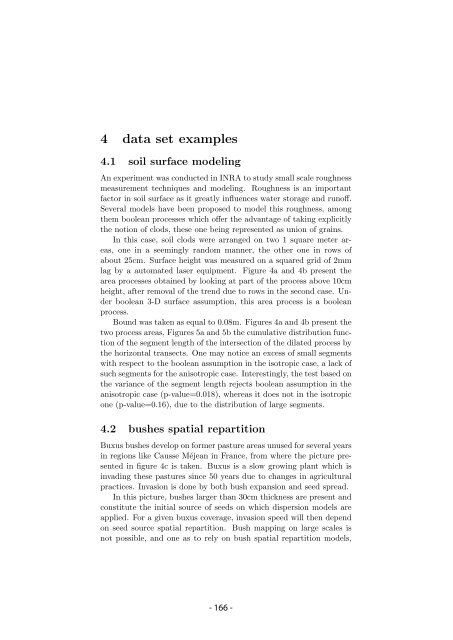Ecole Nationale Supérieure Agronomique de Montpellier ... - CIAM
Ecole Nationale Supérieure Agronomique de Montpellier ... - CIAM
Ecole Nationale Supérieure Agronomique de Montpellier ... - CIAM
Create successful ePaper yourself
Turn your PDF publications into a flip-book with our unique Google optimized e-Paper software.
4 data set examples<br />
4.1 soil surface mo<strong>de</strong>ling<br />
An experiment was conducted in INRA to study small scale roughness<br />
measurement techniques and mo<strong>de</strong>ling. Roughness is an important<br />
factor in soil surface as it greatly influences water storage and runoff.<br />
Several mo<strong>de</strong>ls have been proposed to mo<strong>de</strong>l this roughness, among<br />
them boolean processes which offer the advantage of taking explicitly<br />
the notion of clods, these one being represented as union of grains.<br />
In this case, soil clods were arranged on two 1 square meter areas,<br />
one in a seemingly random manner, the other one in rows of<br />
about 25cm. Surface height was measured on a squared grid of 2mm<br />
lag by a automated laser equipment. Figure 4a and 4b present the<br />
area processes obtained by looking at part of the process above 10cm<br />
height, after removal of the trend due to rows in the second case. Un<strong>de</strong>r<br />
boolean 3-D surface assumption, this area process is a boolean<br />
process.<br />
Bound was taken as equal to 0.08m. Figures 4a and 4b present the<br />
two process areas, Figures 5a and 5b the cumulative distribution function<br />
of the segment length of the intersection of the dilated process by<br />
the horizontal transects. One may notice an excess of small segments<br />
with respect to the boolean assumption in the isotropic case, a lack of<br />
such segments for the anisotropic case. Interestingly, the test based on<br />
the variance of the segment length rejects boolean assumption in the<br />
anisotropic case (p-value=0.018), whereas it does not in the isotropic<br />
one (p-value=0.16), due to the distribution of large segments.<br />
4.2 bushes spatial repartition<br />
Buxus bushes <strong>de</strong>velop on former pasture areas unused for several years<br />
in regions like Causse Méjean in France, from where the picture presented<br />
in figure 4c is taken. Buxus is a slow growing plant which is<br />
invading these pastures since 50 years due to changes in agricultural<br />
practices. Invasion is done by both bush expansion and seed spread.<br />
In this picture, bushes larger than 30cm thickness are present and<br />
constitute the initial source of seeds on which dispersion mo<strong>de</strong>ls are<br />
applied. For a given buxus coverage, invasion speed will then <strong>de</strong>pend<br />
on seed source spatial repartition. Bush mapping on large scales is<br />
not possible, and one as to rely on bush spatial repartition mo<strong>de</strong>ls,



